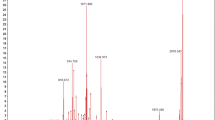Abstract
These studies were performed to investigate the acting sites of ginseng total saponins (GTS) on the U-50,488H-induced antinociception. And the possible mechanisms of the antagonistic effect on the U-50,488H-induced antinociception and the inhibitory effect of the development of tolerance to U-50,488H-induced antinociception by GTS were studied. The U-50,488H-induced antinociception was antagonized in mice pretreated with GTS intraperitoneally, intracerebrally and intrathecally. These antagonisms were reversed by the pretreatment with a serotonin precursor, 5-hydroxytryptophan (5-HTP), but not with a noradrenaline precursor, L-dihydroxyphenylalanine (L-DOPA). However, the intraplantar administration of GTS did not alter the intraplantar U-50,488H-induced antinociception. These findings suggest that U-50,488H-induced antinociception are mediated via the spinal and supraspinal sites. On the other hand, GTS inhibited the development of tolerance to U-50,488H-induced antinociception. The inhibitory effect of GTS on the development of tolerance to U-50,488H-induced antinociception was reversed by pretreatment with 5-HTP, but not with L-DOPA. Therefore, the antagonism of U-50,488H-induced antinociception and the inhibition of the development of tolerance to U-50,488H-induced antinociception by GTS are dependent on serotonergic mechanisms.
Similar content being viewed by others
References Cited
Bhargava, H. N., Ramarao, P. and Gulati, A. Effects of morphine in rats treated chronically with U-50,488H, a k-opioid receptor agonist.Eur. J. Pharmacol., 162, 257–264 (1989).
Basbaum, A. L. and Fields, H. L., Endogenous pain control systems: Brainstem spinal pathways and endorphin circuitry.Ann. Rev. Neurosci., 7, 309–338 (1984).
Berge, O. G., Hole, K. and Ogren, S. O., Attenuation of morphine-induced analgesia by p-chlorophenylalanine and p-chloroamphetamine: Test-dependent effects and evidence for brainstem 5-hydroxytryptamine involvement.Brain Res., 271, 51–64 (1983).
D’Amour, F. E. and Smith, D. L., A method for determining loss of pain sensation.J. Pharmacol. Exp. Ther., 72, 74–79 (1941).
Duart, I. D. G., Lorenzetti, B. B. and Ferreira, S. H., Peripheral analgesia and activation of the nitric oxidecyclic GMP pathway.Eur. J. Pharmacol., 186, 289–291 (1990).
Haley, T. J. and McCormick, W. G., Pharmacological effects produced by intracerebral injection of drugs in the conscious mouse.Br. J. Pharmacol., 67, 313–316 (1957).
Janice, L. K. H. and Wilcox, G. L., Intrathecal morphine in mice: A new technique.Eur. J. Pharmacol., 12, 12–15 (1980).
Kim, H. S., Oh, K. W., Rheu, H. M. and Kim, S. H., Antagonism of U-50,488H-induced antinociception by ginseng total saponin is dependent on serotonergic mechanisms.Pharmacol. Biochem. Behav., 42, 587–593 (1992).
Kim, H. S., Jang, C. G. and Lee, M. G., Antinarcotic effects of the standardized ginseng extract G115 on morphine.Planta Medica., 56, 158–163 (1990).
Kim, H. S., Oh, K. W. and Oh, S. K., Antagonism of analgesic effect of morphine in mice by ginseng saponins.J. Kor. Pharm. Sci., 16, 135–138 (1986).
Lahti, R. A., VonVoitglander, P. F. and Barsuhm, C., Properties of a selective κ-agonist, U-50,488H.Life Sci., 31, 2257–2260 (1982).
Millan, M. J., Czlonkowski, A., Lipkowski, A. and Herz, A., Kappa-opioid receptor-mediated antinociception in the rat. II. Supraspinal in addition to spinal sites of action.J. Pharmacol. Exp. Ther., 251, 342–350 (1989).
Mark, J. M., κ-Opioid receptors and analgesia.TiPS., 11, 70–76 (1990).
Martin, W. R., Eades, C. G., Thompson, J. A., Huppler, R. E. and Gilbert, P. E., The effects of morphine and nalorphine-like drugs in the nondependent and morphine-dependent chronic spinal dog.J. Pharmacol. Exp. Ther., 197, 517–532 (1976).
Namba, T., Yoshizaki, T., Tominori, K., Kobashi, K., Mitsui, K. and Hasse, J., Fundamental studies on the evaluation of the crude drugs (1).Planta Medica, 32, 588–602 (1974).
Panerai, A. E., Martini, A., Sacerdote, P. and Mantegazza, P., κ-Receptor antagonist reverse ‘non-opioid’ stress-induced analgesia.Brain Res., 304, 153–156 (1984).
Petkov, V. W., Effect of ginseng on the brain biogenic monoamines and 3′,5′-AMP system. Arzneim.Forsch./Drug Res., 28, 388–393 (1978).
Roberts, M. H. T., Sizer, A. R. and Rees, H., In Besson, J. M. (Ed),Serotonin and Pain, Elsevier Press, Amsterdam (1990).
Stein, C., Millan, N. J., Shippenberg, T. S., Peter, K. and Herz, A., Peripheral opioid receptors mediating antinociception in inflammation: Evidence for involvement of mu, delta and kappa receptors.J. Pharmacol. Exp. Ther., 248, 1269–1275.
Taber, R. I. and Latranyi, M. B., Antagonism of the analgesic effects of opioid and non-opioid agents by p-chlorophenylalanine (pCPA).Eur. J. Pharmacol., 75, 215–222 (1981).
Takagi, H., Takahashi, T. and Kimura, K., Antagonism of the analgesic effects of morphine in mice by tetrabenazine and reserpine.Arch. Int. Pharmacodyn. Ther., 149, 484–492 (1964).
Takagi, H., Inukai, T. and Nakama, M., A modification of Haffner’s method for testing analgesics.Jpn. J. Pharmacol., 16, 287–294 (1966).
Takahashi, M., Tokuyama, S. and Kaneto, H., Implication of endogenous opioid mechanism in the production of the antinociceptive effect induced by psychological stress in mice.Jpn. J. Pharmacol., 44, 283–291 (1987).
Tenen, S. S., Antagonism of the analgesic effect of morphine and other drugs byp-chlorophenylalanine, a serotonin depletor.Psychopharmacologia, 12, 278–285 (1968).
Tyers, M. B., A classification of opiate receptors that mediate antinociception in animals.Br. J. Pharmacol., 69, 503–512 (1980).
VonVoitglander, P. F. and Lewis, R. A., U-50,488H, a selective kappa opioid agonist: Comparison to other reputed kappa agonists.Pro. Neur. Psychopharmacol. Biol. Psychiat., 6, 460–467 (1982).
VonVoitglander, P. F., Lahti, R. A. and Ludens, J. H., U-50,488H: A selective and structually novel non-mu (kappa) opioid agonist.J. Pharmacol. Exp. Ther., 224, 7–12 (1982).
VonVoitglander, P. F., Lewis, R. A. and Neff, G. L., Kappa-opioid analgesia is dependent on serotonergic mechanisms.J. Pharmacol. Exp. Ther., 231, 270–274 (1984).
Author information
Authors and Affiliations
Rights and permissions
About this article
Cite this article
Kim, HS., Kim, SH., Seong, YH. et al. Effects of ginseng total saponins on the antinociception and the tolerance development of U-50,488H. Arch. Pharm. Res. 16, 237–243 (1993). https://doi.org/10.1007/BF02974489
Received:
Issue Date:
DOI: https://doi.org/10.1007/BF02974489




